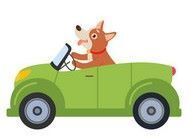I'm not sure where the phrase "fighting like cats and dogs" comes from, but in the majority of homes I am acquainted with, dogs and cats share living quarters quite amicably. In fact, it is often more difficult to introduce a second male cat or a second female dog to a household than it is a member of the other species.
There are exceptions, of course. Socializing stray cats that border on feral presents a serious health risk to resident dogs, even friendly ones. Dogs with strong prey drive (the desire to catch, shake, and kill) can put the family cat in considerable danger.
Do Fence Them In
To make a successful inter-species introduction in the average household, one needs little more than a dog who understands a few rudimentary commands and a sturdy baby gate. A canine who has learned to respond to basics such as "leave it," "down," and "come" can most likely be controlled around a new cat while indoors.
Outdoors is another matter completely. Many otherwise cat-friendly dogs view outdoor cats as prey to be chased down and dispatched — a strong case for keeping cats indoors (particularly when the dog is out in the yard) and dogs on a leash when out for a walk!
If the resident dog lacks basic manners or is the newcomer, a four-foot house leash and buckle collar can give the caretaker control over the situation. If he shows the slightest interest in chasing the cat, growl "Leave it" at him and reward him when he looks away from the cat. When the dog rushes past in a raucous game of "catch the cat," step on the end of the leash. As the dog brakes and turns to look at you, utter your "sit" or "down" command. Don't forget to reward the dog when he complies.
The baby gate is crucial in providing the cat with a dogfree sanctuary. A nervous feline can hop the gate to find a safe haven, and the food bowl placed behind it will be untouched by canine slobber. First, you may have to teach the dog to respect the gate — or invest in an extra-tall one.
What's the Scoop?
Placing the litter box behind the gate will ensure that cat feces stay right where the cat leaves them. You may be thinking, "Ugh, how tasteless!" but the dog's response is more likely to be, "Yum! How tasty!" Anticipate this eventuality and prepare for it.
In some situations, a gate will not be a viable solution. If this is the case in your home, creative thinking will play a crucial role in household management. Is your bathtub tall and your dog small? If so, then a litter box at one end and a food dish at the other will adequately meet your cat's needs.
A covered litter box prevents thievery in some cases, but beware! More than one dog has managed to lodge its head in the box and run hither and yon trying to break free. In one household, the cat was actually in the litter box when the dog got the cover stuck on his head. Could a case of lapsed litter box visits be far behind?
If you own your home, there are more viable options open to you. Some folks cut cat-size openings in closet doors or bathroom vanities as a good way to keep Bowser out of the cat box and keep the box itself out of public view.
Separate Tables
As for alternative feeding stations, countertops and wide window sills can provide out-of-reach dining spots for felines. Remember, cat foods and dog foods are not interchangeable. Much research has gone into developing specialized canine and feline diets. Keeping them out of each other's bowls is crucial.
With a little forethought, a home occupied by dogs and cats is a living example of the Peaceable Kingdom. Thoughtful management can guarantee that a full house is always a winner.
Information adapted from Jacque Lynn Schultz, CPDT








